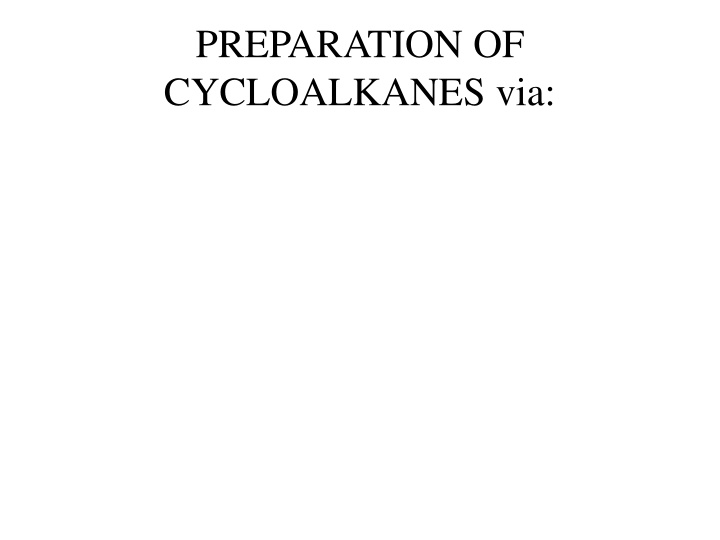
Cycloalkanes and Their Chemical Properties
Discover the preparation of cycloalkanes via conjugated diene and alkene reactions, as well as the unique chemical properties exhibited by cycloalkanes and cycloalkenes. Explore the reactivity of cycloalkanes, cycloalkenes, and their derivatives, including intramolecular cyclisation reactions and electrocyclic reactions. Learn how cyclopropane ring opening occurs due to its high strain energy release.
Download Presentation

Please find below an Image/Link to download the presentation.
The content on the website is provided AS IS for your information and personal use only. It may not be sold, licensed, or shared on other websites without obtaining consent from the author. If you encounter any issues during the download, it is possible that the publisher has removed the file from their server.
You are allowed to download the files provided on this website for personal or commercial use, subject to the condition that they are used lawfully. All files are the property of their respective owners.
The content on the website is provided AS IS for your information and personal use only. It may not be sold, licensed, or shared on other websites without obtaining consent from the author.
E N D
Presentation Transcript
PREPARATION OF CYCLOALKANES via:
conjugated diene and alkene form cyclohexene. Relative alkenes called dienophiles have electron attracting group on their unsaturated carbons .
as 1,4-addition of an olefine (ethene) to a conjugated diene( 1,3-butadiene) and such is called [4+2] cycloaddition reaction.
new molecule is formed from a conjugated 4pi-electron system on the one hand and a 2pi electron system on the other hand. Other examples are as follows, involving derivatives of the cycloaddition product;
CHEMICAL PROPERTIES OF CYCLIC HYDROCARBONS
are similar to those of acyclic alkanes and alkenes. E.g cycloalkanes undergo heat or light-induced halogination in a manner similar to the halogenation reaction of the acyclic alkanes.
Cycloalkenes also exhibit the same reactions as their acyclic counterparts.
Other derivatives behave like acyclic hydrocarbon in their reactivity.
easily than we might expect for a molecule that has only C-C single bond. This occur in cyclopropane easily because of its high strain , the release of strain energy provides the driving force for the ring opening process.
requires higher temperature and more severe reaction conditions than those for cyclopropane. Cycloalkanes with ring sizes greater than four are completely resistant to ring opening reaction.
that the Pi-electrons are delocalized over the entire ring system and they are stabilized by the Pi-electron delocalization called RESONANCE. For instance, Benzene is represented by the Kekule structure.
RESONANCE STRUCTURE OF BENZENE
pie-electrons in the benzene is delocalized and not restricted to any carbon atom- a kind of multicenter bonding or delocalized bonding. The two canonical forms exist. The implication of the parameter highlited above is an indication that the double bonds in benzene is unlike that found in alkene. In fact experiment has shown that benzene does not undergo addition reaction, expected in a a C-C double bond in alkene.
along gas lines of London. The molecular formula is C6H6. For comparison , a saturated alkane of six carbon atoms has the molecular formula C6H14 and saturated cycloalkane of six carbon atom has molecular formula of C6H12.
not undergo addition, oxidation and reduction reactions, characteristics of alkenes and alkynes. E.g it does no decolorizes bromine water, not oxidized by KMnO4 or Chromic acid (CrO3) under conditions that readily oxidizes alkenes and alkynes. Infact, benzene undergoes substitution reaction just like alkanes.
attached to each carbon. To maintain the then established tetravalency of carbon , Kekule further proposed that the ring contains three double bonds that shift back and forth so rapidly that the two forms (1a and 1b below) cannot be separated.
The model above is called Kekules structure.
The Kekules structure was found to be consistent with many experimental observations.
HOME PRACTICE: If benzene contain three double bonds, why does it not show reaction typical of alkene?
the plane of the ring. These p-orbitals overlap equally with each of the two adjacent p-orbital to form a pie- electron system parallel to and above and below the plane of the ring. The six p-electrons in the pi-system are associated with six carbon atoms. They are therefore more delocalized and this accounts for the great stability and large resonance energy of aromatic rings.ie,
The unusual properties of benzene collectively known as aromatic characters are;-
reaction with polar reagents such as HNO3, H2SO4and Br2. The unsaturated bonds in the ring is preserved in this reaction
CALCULATING THE RESONANCE ENERGY
C-C is -206.3KJ/mol and - 225.9KJ/mol for C-H. these data can be used to calculate the heat of combustion for benzene. The difference between this value and the experimental value gives the resonance energy. For example, in benzene, there are; 6 C-H bonds, 3 C-C bonds, 3 C=C bonds.
6 C-C bonds = ( 6x -225.9) KJ/mol = - 1355.4KJ/mol
3 C-C bonds = (3x -206.3) KJ/mol = - 618.9 KJ/mol
3 C=C bonds = (3x -492.5)KJ/mol = -1477.5KJ/mol
